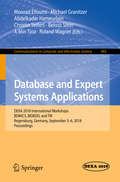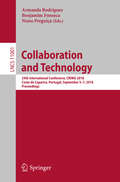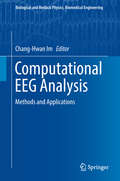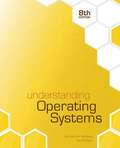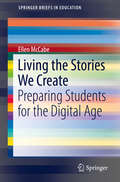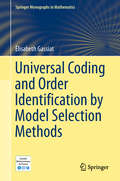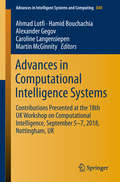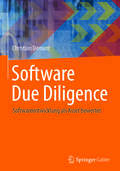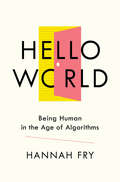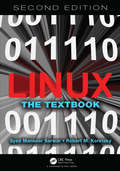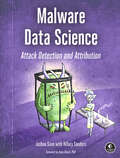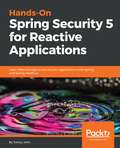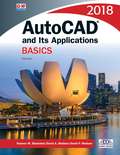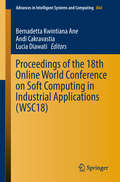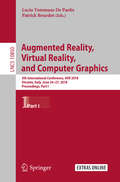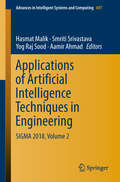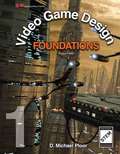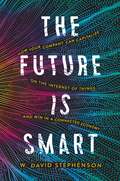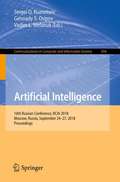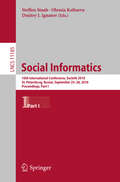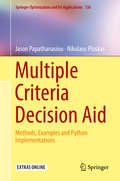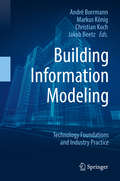- Table View
- List View
Database and Expert Systems Applications: DEXA 2018 International Workshops, BDMICS, BIOKDD, and TIR, Regensburg, Germany, September 3–6, 2018, Proceedings (Communications in Computer and Information Science #903)
by Mourad Elloumi Abdelkader Hameurlain Roland Wagner A Min Tjoa Michael Granitzer Christin Seifert Benno SteinThis volume constitutes the refereed proceedings of the three workshops held at the 29th International Conference on Database and Expert Systems Applications, DEXA 2018, held in Regensburg, Germany, in September 2018: the Third International Workshop on Big Data Management in Cloud Systems, BDMICS 2018, the 9th International Workshop on Biological Knowledge Discovery from Data, BIOKDD, and the 15th International Workshop on Technologies for Information Retrieval, TIR.The 25 revised full papers were carefully reviewed and selected from 33 submissions. The papers discuss a range of topics including: parallel data management systems, consistency and privacy cloud computing and graph queries, web and domain corpora, NLP applications, social media and personalization
Collaboration and Technology: 24th International Conference, CRIWG 2018, Costa de Caparica, Portugal, September 5-7, 2018, Proceedings (Lecture Notes in Computer Science #11001)
by Armanda Rodrigues Benjamim Fonseca Nuno PreguiçaThis book constitutes the refereed proceedings of the 24th International Conference on Collaboration and Technology, CRIWG 2018, held in Costa de Caparica, Portugal, in September 2018.The 11 revised full papers presented together with 6 short papers were carefully reviewed and selected from 32 submissions. The papers published in the proceedings of this year span dierent areas of collaborative computing research, from collaborative learning to collaboration through social media and virtual communities.
Computational EEG Analysis: Methods and Applications (Biological and Medical Physics, Biomedical Engineering)
by Chang-Hwan ImThis book introduces and reviews all of the currently available methods being used for computational electroencephalogram (EEG) analysis, from the fundamentals through to the state-of-the-art. The aim of the book is to help biomedical engineers and medical doctors who use EEG to better understand the methods and applications of computational EEG analysis from a single, well-organized resource. Following a brief introduction to the principles of EEG and acquisition techniques, the book is divided into two main sections. The first of these covers analysis methods, beginning with preprocessing, and then describing EEG spectral analysis, event-related potential analysis, source imaging and multimodal neuroimaging, and functional connectivity analysis. The following section covers application of EEG analysis to specific fields, including the diagnosis of psychiatric diseases and neurological disorders, brain-computer interfacing, and social neuroscience. Aimed at practicing medical specialists, engineers, researchers and advanced students, the book features contributions from world-renowned biomedical engineers working across a broad spectrum of computational EEG analysis techniques and EEG applications.
Understanding Operating Systems
by Ida M. Flynn Ann McHoesProvide a clear, straightforward explanation of both operating system theory and practice for your students with UNDERSTANDING OPERATING SYSTEMS, 8E. As in previous trusted editions, this award-winning book's highly regarded structure begins with a valuable discussion of fundamentals before introducing specific operating systems. Fully updated, timely content offers an expanded analysis of how innovations, such as multi-core processing and wireless technologies, have impacted today's operating systems. Revised Research Topics within this edition's practical exercises encourage independent student research of emerging and influential topics. Updates throughout the final four chapters now highlight information on the most current versions of UNIX (including the latest Macintosh OS), Linux, Windows, and Android to prepare your students for success in working with today's systems.
Living the Stories We Create: Preparing Students for the Digital Age (SpringerBriefs in Education)
by Ellen McCabeThis work explores the potential of digital media to rectify the disparity between formal learning contexts and contemporary perceptions and expectations of narrative. How can education systems respond to the changing technological landscape, thus preparing students to become active participants in society as well as to realise the extent of their own potential? This book explores such concepts in the classroom environment through direct engagement with students and teachers with the case of Shakespeare's Macbeth. Written in approximately 1606, Macbeth has its roots in a culture of orality and yet has sustained through centuries of print dominance. Indeed, as both text and performance the work itself embodies both the literary and the oral. Yet as a staple of many second level curricula increasingly Macbeth is perceived as an educational text. Macbeth reflects its cultural moment, an age of ambiguity where much like today notions of selfhood, privacy, societal structures, media and economy were being called into question. Thus Macbeth can be understood as a microcosm of the challenges existing in contemporary education in both content and form. This book examines Macbeth as a case-study in seeking to explore the implications of digital media for learning, as well as its possible potential to constructively facilitate in realigning formal learning contexts to contemporary experiences of narrative.
Universal Coding and Order Identification by Model Selection Methods (Springer Monographs in Mathematics)
by Élisabeth Gassiat Anna Ben-HamouThe purpose of these notes is to highlight the far-reaching connections between Information Theory and Statistics. Universal coding and adaptive compression are indeed closely related to statistical inference concerning processes and using maximum likelihood or Bayesian methods. The book is divided into four chapters, the first of which introduces readers to lossless coding, provides an intrinsic lower bound on the codeword length in terms of Shannon’s entropy, and presents some coding methods that can achieve this lower bound, provided the source distribution is known. In turn, Chapter 2 addresses universal coding on finite alphabets, and seeks to find coding procedures that can achieve the optimal compression rate, regardless of the source distribution. It also quantifies the speed of convergence of the compression rate to the source entropy rate. These powerful results do not extend to infinite alphabets. In Chapter 3, it is shown that there are no universal codes over the class of stationary ergodic sources over a countable alphabet. This negative result prompts at least two different approaches: the introduction of smaller sub-classes of sources known as envelope classes, over which adaptive coding may be feasible, and the redefinition of the performance criterion by focusing on compressing the message pattern. Finally, Chapter 4 deals with the question of order identification in statistics. This question belongs to the class of model selection problems and arises in various practical situations in which the goal is to identify an integer characterizing the model: the length of dependency for a Markov chain, number of hidden states for a hidden Markov chain, and number of populations for a population mixture. The coding ideas and techniques developed in previous chapters allow us to obtain new results in this area. This book is accessible to anyone with a graduate level in Mathematics, and will appeal to information theoreticians and mathematical statisticians alike. Except for Chapter 4, all proofs are detailed and all tools needed to understand the text are reviewed.
Advances in Computational Intelligence Systems: Contributions Presented at the 18th UK Workshop on Computational Intelligence, September 5-7, 2018, Nottingham, UK (Advances in Intelligent Systems and Computing #840)
by Alexander Gegov Ahmad Lotfi Hamid Bouchachia Caroline Langensiepen Martin McGinnityThis book presents the latest trends in and approaches to computational intelligence research and its application to intelligent systems. It covers a long list of interconnected research areas, such as fuzzy systems, neural networks, evolutionary computation, clustering and classification, machine learning, data mining, cognition and robotics, and deep learning. The individual chapters are based on peer-reviewed contributions presented at the 18th Annual UK Workshop on Computational Intelligence (UKCI-2018), held in Nottingham, UK on September 5-7, 2018. The book puts a special emphasis on novel methods and reports on their use in a wide range of applications areas, thus providing both academics and professionals with a comprehensive and timely overview of new trends in computational intelligence.
Software Due Diligence: Softwareentwicklung als Asset bewertet
by Christian DemantDieses praxisnahe Buch gibt einen Einblick in die Besonderheiten und vermeintlichen Geheimnisse der Softwareentwicklung. Dabei werden Methoden aufgezeigt, um die in der Softwareentwicklung versteckten Verm#65533;genswerte zu ermitteln und transparent zu machen. Software durchdringt immer mehr Bereiche in Industrie und Wirtschaft. IT-Management und Softwareentwicklung, die aktuell vielerorts noch als reine Unterst#65533;tzungs-Funktionen betrachtet werden, k#65533;nnten sich im Zuge der Digitalisierung in den n#65533;chsten Jahren in vielen Unternehmen zu Kernkompetenzen entwickeln. Um hierf#65533;r die aus unternehmerischer Sicht richtigen Weichenstellungen vornehmen zu k#65533;nnen, ist eine Positionsbestimmung die Voraussetzung. Die Zielgruppen Das Buch richtet sich an Wirtschaftspr#65533;fer, Steuerberater, Investoren, Business-Angels, M&A-Verantwortliche bei Banken sowie Inhaber und Gesch#65533;ftsf#65533;hrer von Softwareunternehmen oder Unternehmen, in denen die Softwareentwicklung einen wesentlichen Beitrag zur Wertsch#65533;pfung liefert.
Hello World: Being Human in the Age of Algorithms
by Hannah FryShortlisted for the 2018 Royal Society Investment Science Book Prize A look inside the algorithms that are shaping our lives and the dilemmas they bring with them. If you were accused of a crime, who would you rather decide your sentence—a mathematically consistent algorithm incapable of empathy or a compassionate human judge prone to bias and error? What if you want to buy a driverless car and must choose between one programmed to save as many lives as possible and another that prioritizes the lives of its own passengers? And would you agree to share your family’s full medical history if you were told that it would help researchers find a cure for cancer? These are just some of the dilemmas that we are beginning to face as we approach the age of the algorithm, when it feels as if the machines reign supreme. Already, these lines of code are telling us what to watch, where to go, whom to date, and even whom to send to jail. But as we rely on algorithms to automate big, important decisions—in crime, justice, healthcare, transportation, and money—they raise questions about what we want our world to look like. What matters most: Helping doctors with diagnosis or preserving privacy? Protecting victims of crime or preventing innocent people being falsely accused? Hello World takes us on a tour through the good, the bad, and the downright ugly of the algorithms that surround us on a daily basis. Mathematician Hannah Fry reveals their inner workings, showing us how algorithms are written and implemented, and demonstrates the ways in which human bias can literally be written into the code. By weaving in relatable, real world stories with accessible explanations of the underlying mathematics that power algorithms, Hello World helps us to determine their power, expose their limitations, and examine whether they really are improvement on the human systems they replace.
Linux: The Textbook, Second Edition
by Syed Mansoor Sarwar Robert M KoretskyLinux: The Textbook, Second Edition provides comprehensive coverage of the contemporary use of the Linux operating system for every level of student or practitioner, from beginners to advanced users. The text clearly illustrates system-specific commands and features using Debian-family Debian, Ubuntu, and Linux Mint, and RHEL-family CentOS, and stresses universal commands and features that are critical to all Linux distributions. The second edition of the book includes extensive updates and new chapters on system administration for desktop, stand-alone PCs, and server-class computers; API for system programming, including thread programming with pthreads; virtualization methodologies; and an extensive tutorial on systemd service management. Brand new online content on the CRC Press website includes an instructor’s workbook, test bank, and In-Chapter exercise solutions, as well as full downloadable chapters on Python Version 3.5 programming, ZFS, TC shell programming, advanced system programming, and more. An author-hosted GitHub website also features updates, further references, and errata. Features New or updated coverage of file system, sorting, regular expressions, directory and file searching, file compression and encryption, shell scripting, system programming, client-server–based network programming, thread programming with pthreads, and system administration Extensive in-text pedagogy, including chapter objectives, student projects, and basic and advanced student exercises for every chapter Expansive electronic downloads offer advanced content on Python, ZFS, TC shell scripting, advanced system programming, internetworking with Linux TCP/IP, and many more topics, all featured on the CRC Press website Downloadable test bank, work book, and solutions available for instructors on the CRC Press website Author-maintained GitHub repository provides other resources, such as live links to further references, updates, and errata
The Haskell School of Music: From Signals to Symphonies
by Paul Hudak Donya QuickThis book explores the fundamentals of computer music and functional programming through the Haskell programming language. Functional programming is typically considered difficult to learn. This introduction in the context of creating music will allow students and professionals with a musical inclination to leverage their experience to help understand concepts that might be intimidating in more traditional computer science settings. Conversely, the book opens the door for programmers to interact with music by using a medium that is familiar to them. Readers will learn how to use the Euterpea library for Haskell (http://www.euterpea.com) to represent and create their own music with code, without the need for other music software. The book explores common paradigms used in algorithmic music composition, such as stochastic generation, musical grammars, self-similarity, and real-time interactive systems. Other topics covered include the basics of signal-based systems in Haskell, sound synthesis, and virtual instrument design.
Malware Data Science: Attack Detection and Attribution
by Joshua Saxe Hillary SandersMalware Data Science explains how to identify, analyze, and classify large-scale malware using machine learning and data visualization.Security has become a "big data" problem. The growth rate of malware has accelerated to tens of millions of new files per year while our networks generate an ever-larger flood of security-relevant data each day. In order to defend against these advanced attacks, you'll need to know how to think like a data scientist. In Malware Data Science, security data scientist Joshua Saxe introduces machine learning, statistics, social network analysis, and data visualization, and shows you how to apply these methods to malware detection and analysis. You'll learn how to:- Analyze malware using static analysis- Observe malware behavior using dynamic analysis- Identify adversary groups through shared code analysis- Catch 0-day vulnerabilities by building your own machine learning detector- Measure malware detector accuracy- Identify malware campaigns, trends, and relationships through data visualization Whether you're a malware analyst looking to add skills to your existing arsenal, or a data scientist interested in attack detection and threat intelligence, Malware Data Science will help you stay ahead of the curve.
Hands-On Spring Security 5 for Reactive Applications: Learn effective ways to secure your applications with Spring and Spring WebFlux
by Tomcy JohnSecure your Java applications by integrating the Spring Security framework in your codeKey FeaturesProvide authentication, authorization and other security features for Java applications.Learn how to secure microservices, cloud, and serverless applications easilyUnderstand the code behind the implementation of various security featuresBook DescriptionSecurity is one of the most vital concerns for any organization. The complexity of an application is compounded when you need to integrate security with existing code, new technology, and other frameworks. This book will show you how to effectively write Java code that is robust and easy to maintain.Hands-On Spring Security 5 for Reactive Applications starts with the essential concepts of reactive programming, Spring Framework, and Spring Security. You will then learn about a variety of authentication mechanisms and how to integrate them easily with the Spring MVC application. You will also understand how to achieve authorization in a Spring WebFlux application using Spring Security.You will be able to explore the security confgurations required to achieve OAuth2 for securing REST APIs and integrate security in microservices and serverless applications. This book will guide you in integrating add-ons that will add value to any Spring Security module.By the end of the book, you will be proficient at integrating Spring Security in your Java applicationsWhat you will learnUnderstand how Spring Framework and Reactive application programming are connectedImplement easy security confgurations with Spring Security expressionsDiscover the relationship between OAuth2 and OpenID ConnectSecure microservices and serverless applications with SpringIntegrate add-ons, such as HDIV, Crypto Module, and CORS supportApply Spring Security 5 features to enhance your Java reactive applicationsWho this book is forIf you are a Java developer who wants to improve application security, then this book is for you. A basic understanding of Spring, Spring Security framework, and reactive applications is required to make the most of the book.
Autocad And Its Applications Basics 2018
by David A. Madsen David P. Madsen Terence M. ShumakerAutoCAD and Its Applications: Basics 2018 provides complete instruction for mastering fundamental AutoCAD commands and drawing techniques. The text provides comprehensive coverage of AutoCAD 2D drafting and design. Topics are presented in an easy-to-understand sequence, building upon prior chapter knowledge. The heavily illustrated text not only tells you how to use AutoCAD, it also shows you how to use AutoCAD. In addition to teaching AutoCAD, this text serves as a valuable resource once you begin a career in the drafting and design industry.
Proceedings of the 18th Online World Conference on Soft Computing in Industrial Applications (Advances in Intelligent Systems and Computing #864)
by Bernadetta Kwintiana Ane Andi Cakravastia Lucia DiawatiThis book gathers the papers presented at the 18th Online World Conference on Soft Computing in Industrial Applications (WSC18), which was held on 1-12 December 2014 on the World Wide Web. The conference is open to all academics, students and industrial/commercial parties, and is hosted online between authors and participants over the Internet. The 2014 installment of the Online World Conference on Soft Computing in Industrial Application consisted of a selected keynote speech, invited talks, tutorials, special sessions, and general track papers. The program committee received a total of 51 submissions from 12 countries, reflecting the international nature of the event. Each paper was peer-reviewed (typically by 3 reviewers), culminating in the acceptance of 20 papers for publication.
Augmented Reality, Virtual Reality, and Computer Graphics: 5th International Conference, AVR 2018, Otranto, Italy, June 24–27, 2018, Proceedings, Part I (Lecture Notes in Computer Science #10850)
by Lucio Tommaso De Paolis Patrick BourdotThe 2-volume set LNCS 10850 and 10851 constitutes the refereed proceedings of the 5th International Conference on Augmented Reality, Virtual Reality, and Computer Graphics, AVR 2018, held in Otranto, Italy, in June 2018. The 67 full papers and 26 short papers presented were carefully reviewed and selected from numerous submissions. The papers are organized in the following topical sections: virtual reality; augmented and mixed reality; computer graphics; human-computer interaction; applications of VR/AR in medicine; and applications of VR/AR in cultural heritage; and applications of VR/AR in industry.
Applications of Artificial Intelligence Techniques in Engineering: SIGMA 2018, Volume 2 (Advances in Intelligent Systems and Computing #697)
by Aamir Ahmad Hasmat Malik Smriti Srivastava Yog Raj SoodThe book is a collection of high-quality, peer-reviewed innovative research papers from the International Conference on Signals, Machines and Automation (SIGMA 2018) held at Netaji Subhas Institute of Technology (NSIT), Delhi, India. The conference offered researchers from academic and industry the opportunity to present their original work and exchange ideas, information, techniques and applications in the field of computational intelligence, artificial intelligence and machine intelligence. The book is divided into two volumes discussing a wide variety of industrial, engineering and scientific applications of the emerging techniques.
Covering Politics in a "Post-Truth" America
by Susan B. GlasserIn a new Brookings Essay, Politico editor Susan Glasser chronicles how political reporting has changed over the course of her career and reflects on the state of independent journalism after the 2016 election.The Bookings Essay: In the spirit of its commitment to higquality, independent research, the Brookings Institution has commissioned works on major topics of public policy by distinguished authors, including Brookings scholars. The Brookings Essay is a multi-platform product aimed to engage readers in open dialogue and debate. The views expressed, however, are solely those of the author. Available in ebook only.
The Future is Smart: How Your Company Can Capitalize on the Internet of Things--and Win in a Connected Economy
by W. David StephensonAre you ready for the IoT revolution? The Internet of Things (IoT) will soon be everywhere—embedded in interconnected devices we’ll use every day.Already, cars, appliances, and wearables transmit realtime data to improve performance . . . and new IoT products can even save your life. Consumer goods are just the tip of the iceberg. Amid projections that 30 billion smart devices will be linked in the near future, traditional companies such as Siemens, GE, and John Deere are preparing for profound changes to management, strategy, manufacturing, and maintenance. With the IoT, for example, sensors warn when a critical assembly-line part is about to break, or track how customers actually use products. Data hubs collect and share information instantly with departments, supply chains, partners, and customers— anchoring the organization and replacing hierarchies with circular systems. The Future is Smart documents the shifts now under way. Written by a leading IoT strategist, the book explains how companies are tapping technology to: Optimize supply chains • Maximize quality • Boost safety • Increase efficiency • Reduce waste • Cut costs • Revolutionize product design • Delight customers For those who are ready, the opportunities are endless. This big-think book reveals concrete actions for thriving in this new tech-enabled world.
Diez razones para borrar tus redes sociales de inmediato
by Jaron LanierUn brillante manifiesto que llama a la acción para comenzar a reinventar Internet. ¿Te cuesta imaginar una vida sin redes sociales? ¿Y si te dieran 10 argumentos explicando la toxicidad de sus efectos? En este libro, Jaron Lanier nos explica con una contundencia abrumadora como las redes sociales, al desplegar una vigilancia constante y manipular el inconsciente de sus usuarios, nos están convirtiendo en personas rencorosas, tristes, asustadizas, poco empáticas, aisladas y triviales. Si quieres una vida más feliz, un mundo más justo y pacífico, o simplemente la oportunidad de pensar por ti mismo sin ser monitoreado e influenciado por las corporaciones más ricas de la historia, lo mejor que puedes hacer es cancelar tus cuentas. Ahora. Reseñas:«Jaron Lanier es un genio.»Sunday Times «Mezcla sabiduría profética con una simple practicidad. Lectura esencial.»The New York Times «El título lo dice todo... Lanier aboga por desanclarse de las redes sociales, que fomentan la adicción y la anomia y en general nos hacen sentir peor y más temerosos el uno del otro y del mundo. El experimento podría ser útil, aunque oscurecerá los corazones de los señores oscuros, un argumento ganador por sí mismo.»Kirkus Reviews
Artificial Intelligence: 16th Russian Conference, Rcai 2018, Moscow, Russia, September 24-26, 2018, Proceedings (Communications In Computer And Information Science #934)
by Sergei O. Kuznetsov Gennady S. Osipov Vadim L. StefanukThis book constitutes the proceedings of the 16th Russian Conference on Artificial Intelligence, RCAI 2018, Moscow, Russia, in September 2018. The 22 full papers presented along with 4 short papers in this volume were carefully reviewed and selected from 75 submissions. The conference deals with a wide range of topics, including data mining and knowledge discovery, text mining, reasoning, decision making, natural language processing, vision, intelligent robotics, multi-agent systems, machine learning, ontology engineering.
Social Informatics: 10th International Conference, SocInfo 2018, St. Petersburg, Russia, September 25-28, 2018, Proceedings, Part I (Lecture Notes in Computer Science #11185)
by Steffen Staab Dmitry I. Ignatov Olessia KoltsovaThe two-volume set LNCS 11185 + 11186 constitutes the proceedings of the 10th International Conference on Social Informatics, SocInfo 2018, held in Saint-Petersburg, Russia, in September 2018. The 30 full and 32 short papers presented in these proceedings were carefully reviewed and selected from 110 submissions. They deal with the applications of methods of the social sciences in the study of socio-technical systems, and computer science methods to analyze complex social processes, as well as those that make use of social concepts in the design of information systems.
Multiple Criteria Decision Aid: Methods, Examples and Python Implementations (Springer Optimization and Its Applications #136)
by Jason Papathanasiou Nikolaos PloskasMultiple criteria decision aid (MCDA) methods are illustrated in this book through theoretical and computational techniques utilizing Python. Existing methods are presented in detail with a step by step learning approach. Theoretical background is given for TOPSIS, VIKOR, PROMETHEE, SIR, AHP, goal programming, and their variations. Comprehensive numerical examples are also discussed for each method in conjunction with easy to follow Python code. Extensions to multiple criteria decision making algorithms such as fuzzy number theory and group decision making are introduced and implemented through Python as well. Readers will learn how to implement and use each method based on the problem, the available data, the stakeholders involved, and the various requirements needed. Focusing on the practical aspects of the multiple criteria decision making methodologies, this book is designed for researchers, practitioners and advanced graduate students in the applied mathematics, information systems, operations research and business administration disciplines, as well as other engineers and scientists oriented in interdisciplinary research. Readers will greatly benefit from this book by learning and applying various MCDM/A methods. (Adiel Teixeira de Almeida, CDSID-Center for Decision System and Information Development, Universidade Federal de Pernambuco, Recife, Brazil) Promoting the development and application of multicriteria decision aid is essential to ensure more ethical and sustainable decisions. This book is a great contribution to this objective. It is a perfect blend of theory and practice, providing potential users and researchers with the theoretical bases of some of the best-known methods as well as with the computing tools needed to practice, to compare and to put these methods to use. (Jean-Pierre Brans, Vrije Universiteit Brussel, Brussels, Belgium) This book is intended for researchers, practitioners and students alike in decision support who wish to familiarize themselves quickly and efficiently with multicriteria decision aiding algorithms. The proposed approach is original, as it presents a selection of methods from the theory to the practical implementation in Python, including a detailed example. This will certainly facilitate the learning of these techniques, and contribute to their effective dissemination in applications. (Patrick Meyer, IMT Atlantique, Lab-STICC, Univ. Bretagne Loire, Brest, France)
Building Information Modeling: Technology Foundations and Industry Practice (VDI-Buch)
by André Borrmann Markus König Christian Koch Jakob BeetzBuilding Information Modeling (BIM) refers to the consistent and continuous use of digital information throughout the entire lifecycle of a built facility, including its design, construction and operation. In order to exploit BIM methods to their full potential, a fundamental grasp of their key principles and applications is essential. Accordingly, this book combines discussions of theoretical foundations with reports from the industry on currently applied best practices.The book’s content is divided into six parts: Part I discusses the technological basics of BIM and addresses computational methods for the geometric and semantic modeling of buildings, as well as methods for process modeling. Next, Part II covers the important aspect of the interoperability of BIM software products and describes in detail the standardized data format Industry Foundation Classes. It presents the different classification systems, discusses the data format CityGML for describing 3D city models and COBie for handing over data to clients, and also provides an overview of BIM programming tools and interfaces. Part III is dedicated to the philosophy, organization and technical implementation of BIM-based collaboration, and discusses the impact on legal issues including construction contracts. In turn, Part IV covers a wide range of BIM use cases in the different lifecycle phases of a built facility, including the use of BIM for design coordination, structural analysis, energy analysis, code compliance checking, quantity take-off, prefabrication, progress monitoring and operation. In Part V, a number of design and construction companies report on the current state of BIM adoption in connection with actual BIM projects, and discuss the approach pursued for the shift toward BIM, including the hurdles taken. Lastly, Part VI summarizes the book’s content and provides an outlook on future developments.The book was written both for professionals using or programming such tools, and for students in Architecture and Construction Engineering programs.
